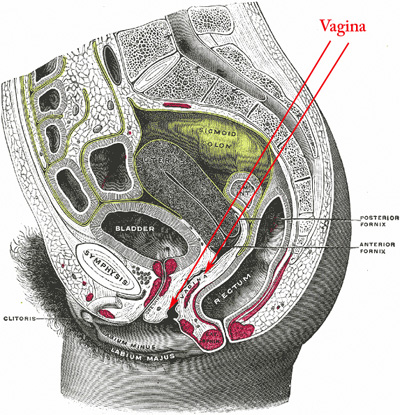DictionaryVagina - Anatomy 1Vagina
VaginaThe vagina is a tubular canal that extends from the vestibule (entrance) of the vulva to the uterine cervix. The vagina is posterior to the urinary bladder and anterior to the rectum with an angle of more than 90 degrees between the axis of the vagina and that of the uterus. In the adult, the vagina measures about 9 cm in length. In the upper part of the vagina, there are small recesses between the vaginal walls and the vaginal portion of the cervix (portio vaginalis) termed fornices. The vaginal wall consists of three layers: mucosa, muscularis and adventitia. The mucosa is folded and, the thickness of the folds varies according to location and hormonal stimulation. The mucosal lining is a stratified squamous epithelium that is normally glycogenated and nonkeratinizing. The basal cell layer consists of a single layer of columnar cells. The nuclei are uniform and hyperchromatic and surrounded by a scant cytoplasm. The parabasal layer consists of two to five layers of cuboidal squamous cells with central, hyperchromatic nuclei. The intermediate and superficial layers are of variable thickness and cells contain moderate to large amounts of cytoplasm. The nuclei of cells in the intermediate layer have a dispersed chromatin, whilst those from the superficial layer have pyknotic nuclei. Variable amounts of glycogen may be present in the intermediate and superficial cell layers. The glycogen first appears in the perinuclear region. The lamina propria lies beneath squamous epithelium. It consists of a loose fibrovascular stroma, containing elastic fibers, nerves and blood vessels. Large, stellate or spindle shaped stromal cells with occasional cells exhibiting multinucleation and/or multilobation may be seen. The muscularis consists of poorly delineated, inner circular and outer longitudinal bundles of smooth muscle. The adventitia comprises a thin coat of dense connective tissue and contains the lymphatic and venous plexuses and nerve bundles. |